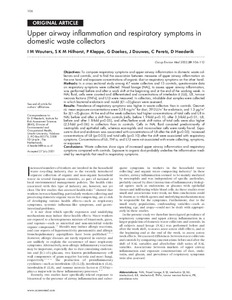Upper airway inflammation and respiratory symptoms in domestic waste collectors

Wouters, I.M. ; Hilhorst, S. ; Kleppe, P. ; Doekes, Gert ; Douwes, Jeroen ; Peretz, C. ; Heederik, Dick
Occupational and Environmental Medicine
2002
59
2
106-112
dust measurement ; epidemiologic study ; occupational disease ; organic dust ; refuse collection ; respiratory impairment ; upper respiratory diseases ; waste disposal
Occupational diseases
English
Bibliogr.
"Objectives: To compare respiratory symptoms and upper airway inflammation in domestic waste collectors and controls, and to find the association between measures of upper airway inflammation on the one hand and exposure concentrations of organic dust or respiratory symptoms on the other hand.
Methods: In a cross sectional study among 47 waste collectors and 15 controls, questionnaire data on respiratory symptoms were collected. Nasal lavage (NAL), to assess upper airway inflammation, was performed before and after a work shift at the beginning and at the end of the working week. In NAL fluid, cells were counted and differentiated and concentrations of interleukin 6 (IL6), IL8, tumour necrosis factor-? (TNF?), and IL1ß were measured. In collectors, inhalable dust samples were collected in which bacterial endotoxin and mould ß(1?3)-glucan were assessed.
Results: Prevalence of respiratory symptoms was higher in waste collectors than in controls. Geometric mean exposure concentrations were 0.58 mg/m3 for dust, 39 EU/m3 for endotoxin, and 1.3
g/m3 for ß(1?3)-glucan. At the end of the week collectors had higher concentrations of total cells and IL8 in NAL before and after a shift than controls (cells, before 1.9-fold p<0.10, after 3.3-fold p<0.01; IL8, before and after 1.8-fold p<0.05), and after/before work shift ratios of total cells were also higher (2.3-fold p=0.06) in collectors than in controls. Cells in NAL fluid consisted predominantly of neutrophils and epithelial cells, whereas eosinophils and mononuclear cells were rarely found. Exposure to dust and endotoxin was associated with concentrations of IL8 after the shift (p<0.05). Increased concentrations of IL8 (p<0.05) and total cells (p<0.10) after the shift were associated with respiratory symptoms. Concentrations of IL6, TNF?, and IL1ß were not associated with waste collecting, symptoms, or exposure.
Conclusions: Waste collectors show signs of increased upper airway inflammation and respiratory symptoms compared with controls. Exposure to organic dust probably underlies the inflammation mediated by neutrophils that result in respiratory symptoms."
Digital
The ETUI is co-funded by the European Union. Views and opinions expressed are however those of the author(s) only and do not necessarily reflect those of the European Union or the ETUI.